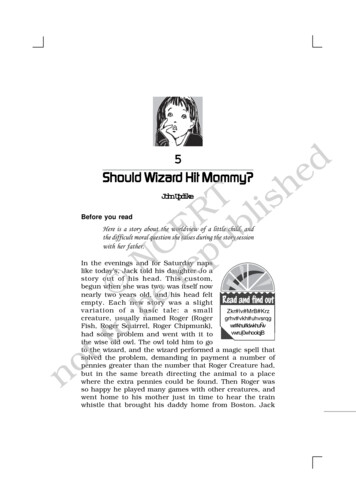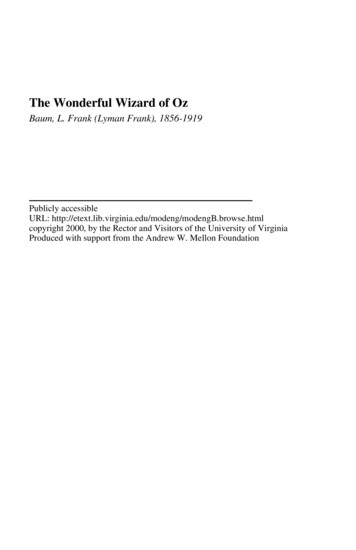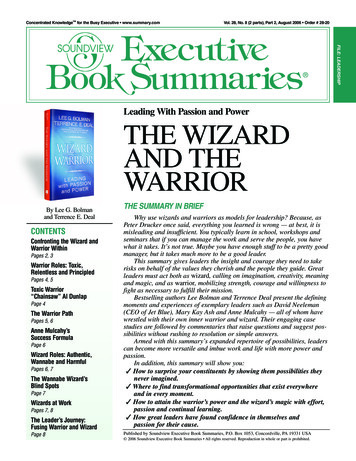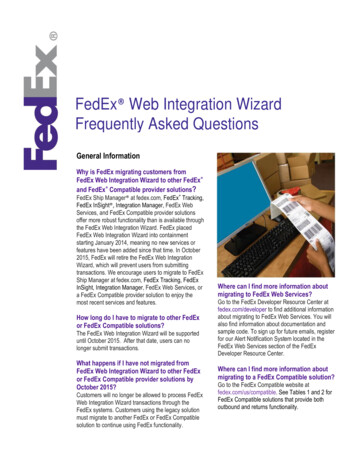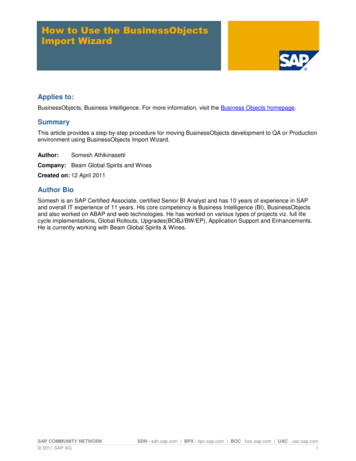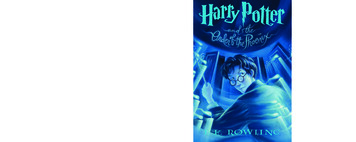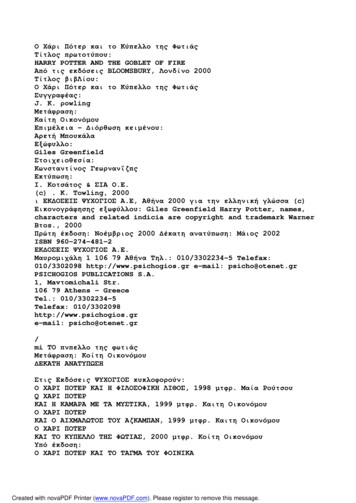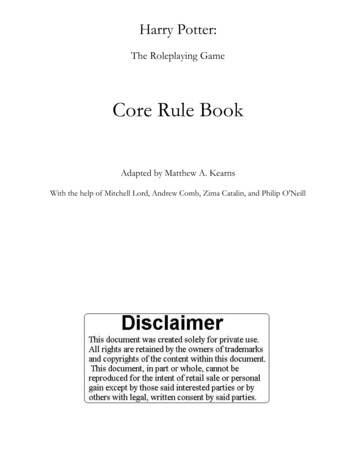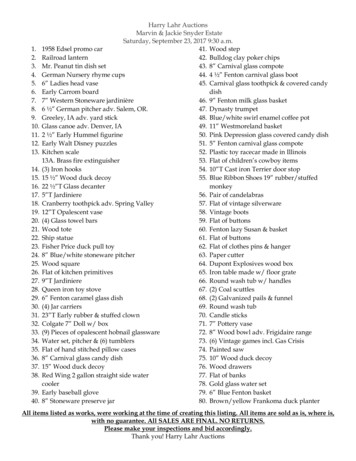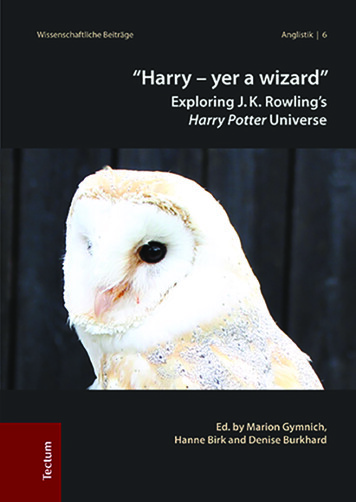
Transcription
Wissenschaftliche Beiträgeaus dem Tectum VerlagReihe Anglistik
Wissenschaftliche Beiträgeaus dem Tectum VerlagReihe AnglistikBand 6Marion Gymnich Hanne Birk Denise Burkhard (Eds.)“Harry – yer a wizard”Exploring J. K. Rowling’sHarry Potter UniverseTectum Verlag
Marion Gymnich, Hanne Birk and Denise Burkhard (Eds.)“Harry – yer a wizard”Exploring J. K. Rowling’s Harry Potter UniverseWissenschaftliche Beiträge aus dem Tectum Verlag,Reihe: Anglistik; Bd. 6 Tectum Verlag – ein Verlag in der Nomos Verlagsgesellschaft, Baden-Baden 2017ISBN: 978-3-8288-6751-2(Dieser Titel ist zugleich als gedrucktes Werk unter der ISBN 978-3-8288-4035-5und als ePub unter der ISBN 978-3-8288-6752-9 im Tectum Verlag erschienen.)ISSN: 1861-6859Umschlaggestaltung: Tectum Verlag, unter Verwendung zweier Fotografienvon Schleiereule Merlin und Janna Weinsch, aufgenommen in der FalknereiPierre Schmidt (Erftstadt/Gymnicher Mühle) Denise BurkhardInformationen zum Verlagsprogramm finden Sie unterwww.tectum-verlag.deBibliografische Informationen der Deutschen NationalbibliothekDie Deutsche Nationalbibliothek verzeichnet diese Publikation in derDeutschen Nationalbibliografie; detaillierte bibliografische Angabensind im Internet über http://dnb.ddb.de abrufbar.Bibliographic information published by the Deutsche NationalbibliothekThe Deutsche Nationalbibliothek lists this publication in the DeutscheNationalbibliografie; detailed bibliographic data are available onlineat http://dnb.ddb.de.
ContentsHanne Birk, Denise Burkhard and Marion Gymnich‘Happy Birthday, Harry!’: Celebrating the Success of the Harry Potter Phenomenon .7Marion Gymnich and Klaus ScheunemannThe ‘Harry Potter Phenomenon’: Forms of World Building in the Novels,the Translations, the Film Series and the Fandom . 11Part I: The Harry Potter Series and its SourcesLaura HartmannThe Black Dog and the Boggart: Fantastic Beasts in Joanne K. Rowling’sHarry Potter and the Prisoner of Azkaban and Where to Find Themin Mythology and Traditional Folklore . 41Franziska BeckerJ.K. Rowling’s Harry Potter: A Revival of the Arthurian Legend? . 51Denise Burkhard and Julia StibaneDarkness, Danger and Death: Exploring Gothic Places in Harry Potterand the Chamber of Secrets . 61Jule LenzenParallels between Celtic Druidism on the British Isles and in Irelandand the Magical World of the Harry Potter Novels . 71Svenja RenzelDouble, Double Toil and (Gender) Trouble: The Gaunt Family . 85Naemi Winter‘I read about it in Hogwarts: A History’: The Reception and Function of Historyin the World of Harry Potter . 95Vera Bub‘The last enemy that shall be destroyed is death’: Christian Elements in Harry Potter ? . 107Part II: Themes and Structures in the Harry Potter SeriesMichèle CibaConspiracy, Persecution and Terror: Harry Potter in a Post-9/11 World . 121Carsten KullmannOf Muggles and Men: Identifying Racism in the Harry Potter Series . 133
Sarah Hofmann‘Can someone just explain what that skull thing was?’: The Workings of Capitalin the Wizarding World . 145Anne SchneiderIs Harry Potter a Criminal? Some Thoughts on Magical Criminal Law . 155Denise BurkhardSecrets and Forbidden Places in Harry Potter and the Philosopher’s Stone . 165Part III: Beyond the Harry Potter SeriesAnne MahlerHaunted by Voldemort or Suffering from PTSD: Analysing Harry Potter’sPsychological Struggles in Adulthood in Harry Potter and the Cursed Child . 183Marthe-Siobhán HeckeQueerbaiting in the Harry Potter Series and in Harry Potter and the Cursed Child ? . 193Aleksandra SzczodrowskiNative Americans in J.K. Rowling’s “History of Magic in North America”on Pottermore . 205Franziska GöbelThe Dark Arts: Violence, Incest and Rape in Harry Potter Fan Fictions . 215Marion Gymnich, Denise Burkhard and Hanne BirkThe Ever-Expanding Potterverse: Harry Potter and the Cursed Child –Fantastic Beasts and Where to Find Them – Pottermore . 225Contributors . 251List of Abbreviations . 255Index . 257
Hanne Birk, Denise Burkhard and Marion Gymnich‘Happy Birthday, Harry!’:Celebrating the Success of the Harry Potter PhenomenonIf there ever was a powerful spell, it was Rowling’s initial incantation when she had Hagridstating in Harry Potter and the Philosopher’s Stone (1997): “‘Harry – yer a wizard’” (Stone42), which was the first spark of a big bang that would bring the Potterverse into being. Thepublication of the first volume of her Harry Potter series (1997-2007) was the beginning ofan amazing success story and of a series which has had a considerable impact on academicresearch. Rowling’s novels have contributed to rendering both children’s literature and thegenre of fantasy more popular than ever – for fans, academics and “fan-scholars” (Hillis 2).Moreover, the novels have played a vital role in establishing the notion of ‘crossover/all-agesliterature’ as one of the key terms within research in the thriving field of children’s and youngadult literature studies. Twenty years after the publication of the first volume, the series seemsto be as culturally visible and enchanting as ever – including now both a sequel, Harry Potterand the Cursed Child, and a tie-in movie, Fantastic Beasts and Where to Find Them, releasedin 2016. By now, the Harry Potter universe has been significantly expanded: apart from theoriginal series it also features audio-visual adaptations of the novels, a prequel, a sequel, theonline platform Pottermore and further tie-in product(ion)s that keep being revisited byscholars and fans from many different disciplines and countries.Most of the contributions in this volume are based on papers given at the Harry Potter students’ conference held at Bonn University on 4th-5th April 2017. The papers in the collectionseek to explore a wide range of different aspects of Rowling’s Harry Potter universe andengage with the wizarding world in innovative ways. Using different theoretical approachesto advance the current state of research, the contributions employ a range of conceptualframeworks such as trauma studies, gender and queer studies, postcolonial studies and folklore studies. The variety of themes covered in the volume already indicates the manifoldvantage points chosen to analyse and interpret Rowling’s works, ranging from the originalseries, her short stories on Pottermore to other facets of the Harry Potter franchise. The aimof the volume is to highlight the diversity of academic approaches that can be used to analyseRowling’s world of Harry Potter as well as to emphasise its topicality twenty years after thepublication of the first novel.Marion Gymnich’s and Klaus Scheunemann’s contribution “The ‘Harry Potter Phenomenon’: Forms of World Building in the Novels, the Translations, the Film Series and the Fandom” focuses on selected facets of the (transmedial) Harry Potter phenomenon, such as thedepiction of Britishness in the series, the creativity of the translators and the specific challenges they had to face, the ‘Rickmann effect’ and hallmarks of the Harry Potter fandom.Corresponding to the manifold aspects identified by Marion Gymnich and Klaus Scheunemann, inter- and transdisciplinary approaches have evolved. Part I introduces some of theseapproaches by elaborating on the connection between the Harry Potter series and its potentialsources. In her contribution, Laura Hartmann examines the Black Dog/Grim and the Boggartin the context of British mythology and traditional folklore. She tries to answer the question inhow far Rowling used, adapted or transformed certain characteristic features of both creaturesand in how far the reader encounters Rowling’s creations. In a similar vein, Franziska Becker,
HANNE BIRK, DENISE BURKHARD AND MARION GYMNICHDenise Burkhard, Julia Stibane and Jule Lenzen address the influence of cultural ‘textualresources’ (Wertsch) on Rowling’s work. Franziska Becker discusses the influence of theArthurian legend on the Harry Potter series (according to the version which can be found inGeoffrey of Monmouth’s Historia Regum Britanniae). The article written by Denise Burkhardand Julia Stibane uses Gothic literary frames as its basis and focuses on Knockturn Alley, theForbidden Forest, Hogwarts and the Chamber of Secrets as Gothic places in Harry Potter andthe Chamber of Secrets (1998). Using accounts on Druidism, Jule Lenzen explores potentialCeltic sources of the Potterverse and tries to correlate Rowling’s depiction of wands, spellsand shape-shifting with possible equivalents found in historical and literary texts on Druids.There are, of course, many other, not exclusively literary sources, such as cognitive frames orsocio-cultural ‘concepts’ that inform the series. Drawing on Victorian gender roles, SvenjaRenzel provides an analysis of the Gaunt family and the ‘gendered agency’ of its members.While Marvolo and his son Morfin tend to adhere to the classical Victorian stereotype of thedominant male, Merope seems to represent the subordinate, victimised female, who lacks avoice of her own. Naemi Winter examines in how far ‘Muggle history’ is alluded to in thefictional universe. The foci of her argumentation include the parallels between the Wizengamot and the Anglo-Saxon ‘Witenagemots’, the incorporation of historical and fictional accounts on alchemy and the Philosopher’s Stone as well as the link between Early Modernwitch hunts, their medieval roots and the Harry Potter novels. Closing the first section, VeraBub’s contribution explores the connection between religious elements/Christian conceptsand Harry Potter and addresses the notion of an afterlife, martyrdom and immortality astopics central to both.In Part II, various themes and structures that pervade the series will be addressed. The firsttwo contributions by Michèle Ciba and Carsten Kullmann discuss the representation of terrorand racism respectively. Focusing on conspiracy, persecution and terror, Michèle Ciba identifies the correlation between conspiracy narratives and Rowling’s novels and analyses fictionalreverberations of the increasing topicality of terror and persecution in post-9/11 public discourses. Precisely these mimetic and poietic potentials of literary texts have already beenconceptualised by scholars such as Winfried Fluck and Hubert Zapf, who assume that one ofthe main functions of literary texts is that of highlighting deficits in a society. In many respects, the Harry Potter series seems to do just that: it addresses, for instance, the issue ofracism and marginalisation by condemning prejudices against the so-called ‘Mudbloods’, anachievement which Carsten Kullmann addresses in his paper “Of Muggles and Men: Identifying Racism in the Harry Potter Series”. Drawing on Bourdieu’s “Forms of Capital” (1986), inwhich he subdivides capital into social, economic and cultural capital, Sarah Hofmann usesvarious examples to illustrate how fruitful and rewarding non-literary concepts can be for theanalysis and interpretation of Rowling’s novels. Anne Schneider poses a highly innovativeand provocative question, namely whether Harry Potter is a criminal and elaborates on the useand function of magical criminal law in the series. Firstly, she reconstructs the Magical Lawsystem as presented in the novels and simultaneously questions its consistency; secondly shelocates the Unforgivable Curses within the topography of the system and subsequently attempts to construct a possible defence for Harry. The final contribution of Part II by DeniseBurkhard focuses on secrets and forbidden places and argues that Rowling tends to connectmysteries and secrets in Harry Potter and the Philosopher’s Stone with spatiality. She examines the Forbidden Forest, the out-of-bounds third-floor corridor and the Mirror of Erised asplaces connected with the secrets revolving around Harry’s identity and the Philosopher’sStone.Part III comprises contributions that ‘go beyond’ the Harry Potter series and focus on thenew stage play Harry Potter and the Cursed Child, Fantastic Beasts and Where to Find8
‘HAPPY BIRTHDAY, HARRY!’Them, Rowling’s writings on Pottermore.com and fan fiction. Applying a psychologicalapproach to Harry Potter and the Cursed Child, the paper by Anne Mahler identifies a rangeof symptoms in Harry that correlate with PTSD. It is also primarily the stage play that informsMarthe-Siobhán Hecke’s paper, which provides a conceptualisation of queerbaiting. Due toher thorough analysis, it becomes clear that the series can hardly be read as an example ofqueerbaiting, whereas the relationship between Albus Potter and Scorpius Malfoy in HarryPotter and the Cursed Child does exhibit clear signs of queerbaiting. Employing postcolonialconcepts, Alexandra Szczodrowski analyses modes of representation of Native Americans inRowling’s “History of Magic in North America” (published on Pottermore) and reveals, forexample, the influence of dominant historiographies and potentially damaging stereotypes. Inher article “The Dark Arts: Violence, Incest and Rape in Harry Potter Fan Fictions”, Franziska Göbel engages critically with the potential merits of reading and writing fan fictions thatinclude depictions of non-consensual sex and abuse. She elaborates on why the series invitesespecially the production of ‘darker fan fictions’ and criticises the terminology that onlineplatforms provide to tag stories, which is often not adequate, especially from an ethical perspective. The final contribution, “The Ever-Expanding Potterverse: Harry Potter and theCursed Child – Fantastic Beasts and Where to Find Them – Pottermore”, discusses variousstrategies of internationalisation and diversification of the Potterverse, which implicitlyaddress how the ever-growing Harry Potter universe answers to the interests of fans andcritics. As the play, the recent movie adaptation, which is only the first of five, and Pottermore already suggest, the Potterverse will continue to expand and enchant fans and readersalike.In this sense: All the best, Harry, and many happy returns!***We would like to express our sincerest gratitude to Vivienne Jahnke, Tamara Kuhn and theentire team at Tectum publishers.Many thanks to Janna Weinsch, who offered to become the witch on the cover photo, and theteam at the Falknerei Pierre Schmidt (Erftstadt/Gymnicher Mühle) for their wonderful helpand support in providing us with the opportunity to take a picture of their beautiful barn owlMerlin.Last but not least, we want to give our heartfelt thanks to the students’ team who organisedthe conference.Works CitedHillis, Matt. Fan Cultures. Routledge, 2002.Rowling, J.K. Harry Potter and the Philosopher’s Stone. Bloomsbury, 1997.Wertsch, James V. Voices of Collective Remembering. Cambridge University Press, 2002.9
Marion Gymnich and Klaus ScheunemannThe ‘Harry Potter Phenomenon’: Forms of World Building in the Novels,the Translations, the Film Series and the Fandom“[ ] there is no doubt that since the advent of Harry Potter, the concept of an international bestsellerfor children has taken on a new meaning as well as a new epithet: ‘phenomenon’” (Lathey 141).I. IntroductionTwo decades after the publication of Harry Potter and the Philosopher’s Stone in 1997, thesuccess of J.K. Rowling’s Harry Potter series has become legendary. As James Russell pointsout, it “may have started out as a series of thrilling novels for children, but Harry Potterbecame the quintessential product of the modern American movie industry: an ultra highbudget, transmedia franchise” (392). Three years after the publication of the first volume, the‘Harry Potter phenomenon’ was already well under way: “After 2000, and the publication ofGoblet of Fire [ ], the ritual of queuing outside a bookshop the night before the book wenton sale became famous” (Sunderland et al. 178). The eager anticipation and media hype thataccompanied the publication of new instalments of the series in the late 1990s and early2000s may seem unusual, at least for novels. Deborah Cartmell and Imelda Whelehan observethatit is easy to compare the marketing of the fourth instalment in the Harry Potter series, Harry Potter andthe Goblet of Fire, released on 8 July 2000, to that of a film. The release of the fourth book was unashamedly promoted according to all the rules of Hollywood’s blockbusters, especially those whichherald a series of films, like Jaws, Star Wars, or The Lord of the Rings. The release-day was announcedmonths before and was celebrated with queues of customers waiting through the night, hundreds ofadults and children attending bookshop events in order to collect their pre-ordered volume (39-40).The film series based on Rowling’s novels has of course also contributed to the ‘Harry Potterphenomenon’, and one can safely assume that by now significantly more people around theworld have watched the entire movie series than have read all of the novels. Still, as far as onecan tell today, for many people the movies have not simply replaced the novels, which continue to be as popular as ever.1There was much speculation about the beneficial effects of the Harry Potter series on children’s literacy and their interest in reading, but it is still more or less an open question howextensive this so-called ‘Harry Potter effect’ on children’s reading habits has really been.Scholars such as Steve Dempster, Alice Oliver, Jane Sutherland and Joanne Thistlethwaiteclaim that the impact may actually have been a bit overestimated, especially since the undeniable length of the later volumes of the series seems to have prevented many young readersfrom finishing the books or even from reading them in the first place. What Dempster, Oliver,Sutherland and Thistlethwaite noticed in their study, however, is that the experience of read1As Michael K. Johnson observes, audio-visual adaptations are actually likely to disappoint fans to acertain extent: “Few film adaptations of beloved novels appear without an accompanying chorus ofcomplaints about the film’s differences and departures from the source text, often expressed, as RobertStam has pointed out, in terms that connote moral violations (unfaithfulness, lack of fidelity)” (207).
MARION GYMNICH AND KLAUS SCHEUNEMANNing the series on the whole does increase young readers’ interest in specific genres, i.e., in“fiction that centre[s] on fantasy, magic, action and adventure” (277). Harry Potter is muchmore than children’s literature, of course. Children and adolescents only constitute one segment of the Harry Potter fan community, and “[o]lder readers have made up a substantialportion of Rowling’s audience from the start”, as Rebecca Sutherland Borah (346) observes.This is also apparent in the fact that Harry Potter has become the prime example of ‘all-ages’or ‘crossover literature’.The emergence of the global ‘Harry Potter phenomenon’ in the late 1990s may partially beaccounted for as a consequence of the innovative strategies of communication that accompanied the publication of the series almost from the start and that made use of new media. Thefirst volumes were published at a time when the internet was gradually becoming a widelyaccessible, everyday medium for many people around the world, which made new forms ofcommunication possible:As the novels were being released, the widespread adoption of the internet was accelerating the possibilities for hype and promotion, and Rowling actively used the web to speak to her fans, and provideinsights into the writing process. Throughout the early 2000s, the Potter novels were very visibly presented to the public as something J.K. Rowling was actively and currently doing (Russell 394, originalemphasis).Since the 1990s, fans have increasingly used the internet to construct an international virtualcommunity, sharing their fascination with the wizarding world in forums or by means of fanfiction. 2 In 2011 Pottermore was established as a platform for representing the franchise,distributing news and additional stories about the fictional Harry Potter universe that have anofficial/canonical status due to being sanctioned or even written by J.K. Rowling (cf. Sharp112). Since its inception, Pottermore has undergone substantial changes in terms of its contents and functions, whose implications we will discuss in more detail below.Though communication and marketing strategies are certainly important for the series’global success, the substance of the Potterverse, i.e., the wizarding world with its countlessmemorable human and non-human inhabitants, its picturesque settings and its unique magicalartefacts, is at least equally significant for making Rowling’s series as popular as it is and forbringing about the ‘Harry Potter phenomenon’. In the following, we will examine variousmedia-specific forms of world building in Rowling’s novels, in translations of these texts, inthe Harry Potter film series as well as on Pottermore and within the fandom, which havejointly shaped the Potterverse as we know it today (and which are still operating in its ongoing expansion).3II. The novelsSomewhat paradoxically, a series whose global fame relies very much on new media hascreated a fictional world that eschews exactly these means of communication, presenting acommunity that uses parchment and quills instead of tablets and books instead of the internet.The old-fashioned, quaint atmosphere that is characteristic of the wizarding world seems to bean important factor in the series’ charm. In this context, Andrew Blake argues that the mani2312Cf. also Megan Farnel’s observation that “the massive scope and scale of Potter’s fanbase has a historywhich is very much intertwined with the rise of the Internet and its increasing adoption in homes duringthe early stages of the series” (40).For a discussion of recent developments in the Potterverse, cf. the article by Marion Gymnich, DeniseBurkhard and Hanne Birk in this volume.
THE ‘HARRY POTTER PHENOMENON’fold references to the past in the “low-tech magical world, with its Victorian London shopping alley and a Highlands boarding school” (305) correlate with a general trend that startedto inform British popular and consumer culture already in the 1980s:The very past itself – our sense of ‘history’ – had been remodelled during the 1980s. The boom years ofthe 1980s indicated that almost any aspect of the past – including historic houses, Victorian gardeningtechniques, even opera – could be packaged as luxury consumer items for people with new wealth. Withthis in mind a younger generation of historians (and museum workers and archaeologists) tried to reinvent the past for present-day consumer culture, and to sell it. [ ] Museums offered not exhibitions, butsimulated experiences of the past. Schools offered simulations of past experience rather than curriculacentred on interpretation; pupils would dress up as medieval peasants rather than learn about the causesof the Wars of the Roses. [ ] The past was also available on the high street. A chain of shops, PastTimes, offered copies of historical artefacts such as eighteenth-century maps or Victorian lamp stands,alongside classic novels and videos of televised costume dramas. History had become ‘heritage’ (306).The world created by Rowling fits neatly into the approach to the past outlined by Blake. Thereaders witness Harry, a modern child, immersing himself in a world that allows him toexperience a picturesque ‘past in the present’, which somewhat eclectically draws uponfeatures of different historical periods and where he can star in the role of an Arthurian knightwith magical powers. 4 While entering the wizarding world means shedding many of theparaphernalia of modern life, which are repeatedly criticised in references to the various(technological) gadgets Harry’s despicable cousin Dudley covets, Hogwarts students do notreally have to do without all of the social achievements of life in the late 20th/early 21stcentury.Unlike in the periods of the past referenced most strongly in the everyday life of the wizarding world, neither ethnicity nor class are allowed to determine someone’s destiny in thewizarding community. As Blake points out, “Hogwarts represents the multicultural contemporary England” (308) and at Hogwarts “the abilities and activities” (ibid.) of a person aregenerally deemed more important than one’s ancestry. The fact that unpleasant characters likethe Malfoys are shown to think differently ultimately only serves to drive this point home allthe more forcefully. It is evidence of the modern outlook of the series that the fight againstevil is also a fight against racial and class prejudices in various manifestations.5 AttendingHogwarts is a bit like entering a simulation of the past in a living-history museum or perhapseven a theme park or Renaissance fair (with the added bonus of adventure and magic). In thisscenario, the protagonist Harry Potter, who embodies modern ideals of justice, equality andagency, can be seen as “a retrolutionary, a symbolic figure of the past-in-future England”(ibid., original emphasis).In the further course of the series, readers find out that many of the potential drawbacks ofdoing without modern technology can be made up for by magic. Travelling by means of floopowder, a portkey or by Apparating gets you much faster from one place to another than anycontemporary Muggle means of transportation possibly could. While communicating via owlmail must appear painfully slow to readers used to (mobile) phones and the internet, the latervolumes of Rowling’s series suggest that there are alternative, faster ways of communicatingin the wizarding world as well; wizards and witches can, for instance, use fireplaces to talk tosomeone or send your Patronus to deliver a message. Still, even magical devices that imitatethe effects of modern technology are by definition profoundly anti-technological, whichimplies that the nostalgia for a way of life that is less determined by technology and is generally more slow-paced than the one of the Harry Potter readers remains essentially intact.45In her contribution to this volume Franziska Becker has a closer look at the Arthurian roots of the series.Cf. the article by Carsten Kullmann in this volume.13
MARION GYMNICH AND KLAUS SCHEUNEMANNThe different literary genres and traditions Rowling draws upon may also contribute to asense of nostalgia triggered especially for many adult readers by the series. Using conventionsof the genre of the boarding-school novel, including themes, stock characters and even thetraditional plot element of the train journey, the Harry Potter series may remind adult readersof novels by authors like Enid Blyton, which they may remember fondly from their childhood.6 The parallels to Gothic literature, especially classic Gothic novels from the late 18thcentury with their medieval castles, dungeons and uncanny forests, reinforce the idea of apicturesque representation of the past in the present.7 In addition, Rowling’s series picks upmany tropes that are familiar from Victorian classics, such as the figure of the maltreatedorphan, who is a staple feature of novels such as Charles Dickens’s Oliver Twist (1837-39)and David Copperfield (1849-50), Emily Brontë’s Wuthering Heights (1847) and CharlotteBrontë’s Jane Eyre (1847), to name just a few.8 The trope of the poor, abused orphan, whichwas employed time and again in Victorian literature to create empathy with literary charactersas well as to express social criticism (cf. Reynolds 272-73), is still effective for today’s readership, adults and children alike. While the boy Harry Potter, the orphan with magical powersand a dark destiny, might not necessarily be a role model for all young readers, his fate iscertainly apt to evoke sympathy. Additionally, values like loyalty, friendship, resilience aswell as a sense of justice and fairness seem to resonate with modern readers as much as theydid with Victorian ones. The dramatic story of Dumbledore’s younger sister Ariana, who washidden away inside the family’s house due to her ‘insanity’, i.e., her inability to control hermagical powers, echoes the Victorian interest in (women’s) ‘madness’. Ariana can be read asa magical (and younger) counterpart of Charlotte Brontë’s ‘madwoman in the attic’ in JaneEyre, whose unstable psychological condition escalates in destruction which is similar to thatcaused by Ariana, who ends up killing her own mother in “one of her rages” (Hallows 455).9What is even more significant with respect to resemblances between 19th-century literatureand the Harry Potter series is the similarity between Rowling’s narrative style and techniquesthat are characteristic of Victorian realist novels. Philip Nel argues that “[o]ne of the assets ofthe Harry P
approach to Harry Potter and the Cursed Child, the paper by Anne Mahler identifies a range of symptoms in Harry that correlate with PTSD. It is also primarily the stage play that informs Marthe-Siobhán Hecke’s paper, w
